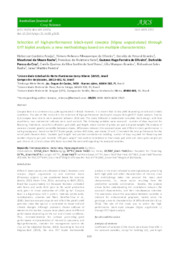Selection of high-performance black-eyed cowpea (Vigna unguiculata) through GYT biplot analysis: a new methodology based on multiple characteristics.
Selection of high-performance black-eyed cowpea (Vigna unguiculata) through GYT biplot analysis: a new methodology based on multiple characteristics.
Author(s): ARAÚJO, K. C.; OLIVEIRA, T. R. A. de; GRAVINA, G. de A.; ROCHA, M. de M.; ALCÂNTARA NETO, F. de; OLIVEIRA, G. H. F. de; CRUZ, D. P. da; SANT'ANNA, C. Q. da S. S. de; GRAVINA, L. M.; ROCHA, R. S.; PEREIRA, I. M.
Summary: Cowpea bean is a common crop quite appreciated in Brazil. However, it is known that its low yield depending on soil and climatic conditions. The aim of this research is the selection of high-performance black-eyed cowpea through GYT biplot analysis. Twelve (12) cowpea bean strains were assessed between 2016 and. The study followed a randomized complete block design, with four repetitions; two commercial cultivars were used ascheck. The following variables were assessed: number of days required for flowering, final stand, value for cultivation, pod yield, pod length, mean number of grains per pod and grain weight. The analysis of variance showed genetic variability between strains, differences between the assessed years and different strain-performance in each growing year. Based on the GYT biplot graph, cultivar BRS Itaim, and strains L9 and L7 recorded the best performance for the set of yield characteristics. Variable ?pod length? had positive correlation to bedding, number of days required for flowering and number of grains per pod. Variable ?100-grain weight? had positive correlation to final stand, pod yield and mean grain weight per pod. Strains L9, L7 and cultivar BRS Itaim recorded the best yield regarding the assessed variables.
Publication year: 2021
Types of publication: Journal article
Unit: Embrapa Mid-North
Observation
Some of Embrapa's publications are published as ePub files. To read them, use or download one of the following free software options to your computer or mobile device. Android: Google Play Books; IOS: iBooks; Windows and Linux: Calibre.
Access other publications
Access the Agricultural Research Database (BDPA) to consult Embrapa's full library collection and records.
Visit Embrapa Bookstore to purchase books and other publications sold by Embrapa.

